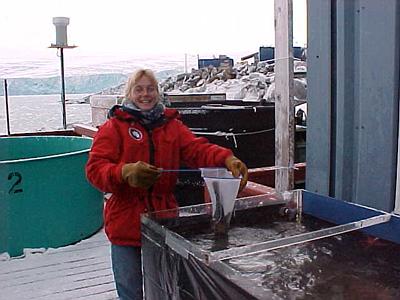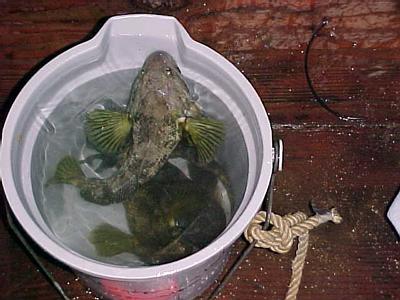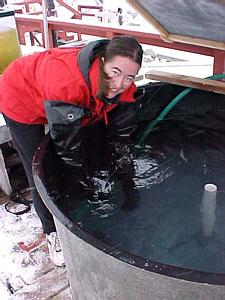25 March, 2000
Fish for Bioassays
Question 35: What is "spy hopping"?
Since it is Saturday, part of my day is dedicated to station tasks--house
mouse at 2 pm, all hands meeting at 3:30 pm, and gashing tonight. Gash is the
nightly clean-up and sanitizing of the kitchen, food preparation and dining
area. Four to five people do it nightly after dinner. It is voluntary but if
someone is shirking the once-a-week responsibility, he may find himself signed
up every night by other people. In a small community like this it is
impossible to go unnoticed.
In the morning I helped get our fish settled in their new home. They will be
part of another bioassay. For the bioassay to work properly, they need to be
comfortable enough to behave naturally and feed. We have approximately twenty
fish (Notothenia coriiceps) that Jim and Andy have caught at the shoreline.
The end of the pier by the seawater intake line is actually a hollow tower
with a room down inside and a hatch that opens to the ocean. We can fish
there in all weather.
Katrin and I transferred the fish from a glass holding tank to one of the
large tanks on the aquarium deck. Although the single fish (lighter colored
than the rest) we could see was acting more naturally in the less exposed
area, the rest of the dark gray/black fish were totally invisible on the
bottom of the black tank. We decided to sew a white plastic mesh covering for
the bottom of the tank. It floated, so we weighted it down with lead weights,
being careful not to trap or squish the fish! Before we carry out the
bioassay, we need to construct dividers for several tanks so the fish can be
isolated.
The fish species we are using is 18 to 42 cm long and a mottled greenish
black with green bands on their fan-like fins. N. coriiceps are opportunistic
generalists, which means they will eat whatever turns up. This includes
limpets, isopods, amphipods (look like tiny shrimp), gastropods (snails) and
macroalgae. The adults are benthic (live by the sea floor). They are found
as deep as 90 meters and all the way up into shallow coastal waters where they
hide among the seaweed and are eaten by cormorants.
N. coriiceps, like all Antarctic fish, are not very active. In the tanks, as
in the ocean, they remain quietly on the bottom, moving only in response to
some stimuli (e.g. food, being chased by a net). Their body shape is not as
streamlined as that of pelagic species (ones that live in the water column).
A cross-section of N. coriiceps body is more teardrop shaped, while a
cross-section of a pelagic fish is shaped more like a cat's pupil. They are
negatively buoyant (they sink) and have heavier skeletons than species that
spend more time in the water column. When they rest on the substrate (rock,
sand, etc.) their body is supported by the pelvic and anal fins. In benthic
Notothenioids (the large group most Antarctic fish belong to) the fins are
modified for their contact with the substrate and body support. The rays of
the fins are thicker and shorter while the skin that makes up the fin is much
thicker.
While diving we have seen several other species of fish, all hiding quietly
in the macroalgae among the rocks. On one of our first dives we found a
dragonfish, a member of the only group of fish here that does not include
species that live north of the Antarctic Convergence.
Answer 34: The Orca or Killer whale. While in some other oceans groups may
eat mainly fish, in the Southern Ocean they mostly eat penguins, seals, and
other whales (especially Minkes).

Andy going fishing.

Fish fin diagram.

Katrin transferring a fish.


Fishing inside the pier tower.

Putting netting in bottom of outdoor fish tank.

Contact the TEA in the field at
.
If you cannot connect through your browser, copy the
TEA's e-mail address in the "To:" line of
your favorite e-mail package.
|
